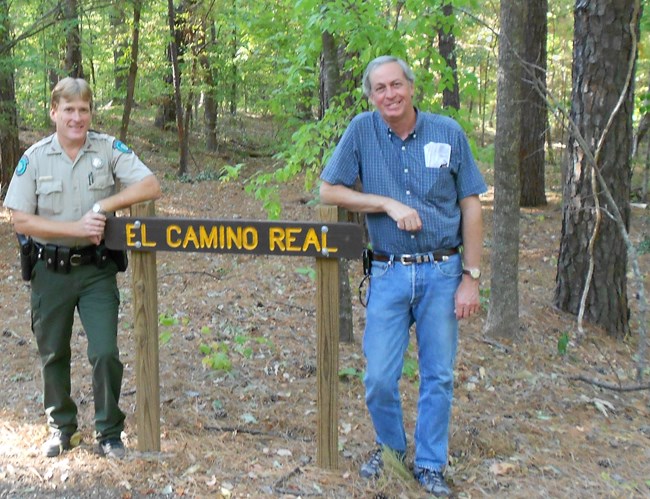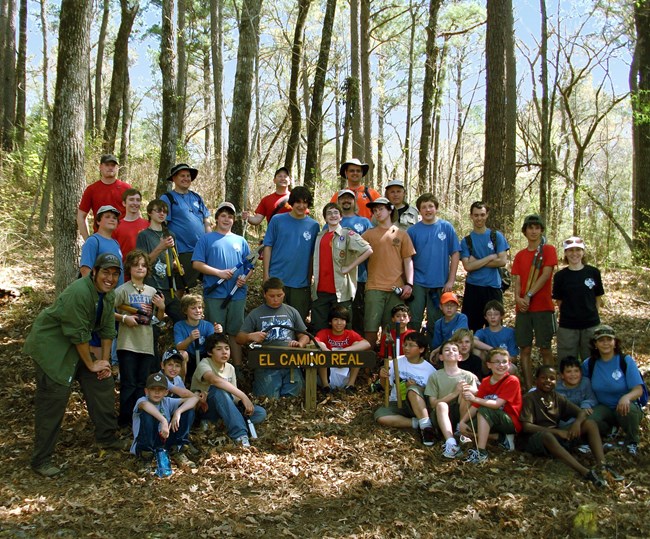Last updated: April 7, 2025
Article
Podcast 035: El Camino Real de los Tejas National Historic Trail

El Camino Real de los Tejas National Historic Trail Association
El Camino Real de los Tejas National Historic Trail
Jenny Hay: Mr. Steven Gonzales, thank you so much for joining us today on this NCPTT podcast. Can you tell me a little about the history of the El Camino Real de los Tejas National Historic Trail?
Steven Gonzales: Sure. El Camino Real de los Tejas, in a nutshell, is what led to the founding of Texas. We would not be calling Texas ‘Texas’ without the trail today. Basically, in the mid 1680s, the first Spanish expeditions began over the Trail as they were searching for their French imperial rivals who had crashed here on the Texas coast. Eventually, they ended up finding a few of those survivors, and making the first trip out to east Texas to near present-day Mission Tejas State Park in far east Texas to establish Mission San Francisco de los Tejas, which was the first mission here in Texas.
Steven Gonzales: So the initial kind of expansion was all about colonial imperialism and battling for territory with the perceived French threat the Spanish saw here in their northern frontier of New Spain. The historic period of significance for the Trail is from 1680 to 1845, so well over 100 years later, after the initial entradas by the Spanish, you started having Anglo settlers come down from the East and heading down the road towards places like San Antonio and Austin. So it really is the trail that led to the founding of Texas and what it is today.
Landscape Preservation
Jenny Hay: Wow, that’s quite a history. How did you become involved in preserving the historic landscape?
Steven Gonzales: Well, as an undergrad student at the University of Texas at Austin, I did a lot of study on Spanish missions and presidios on the northern frontier of New Spain. So I’ve had an interest in the history of the Spanish Colonial period for quite some time. Then I went to grad school at Texas State University-San Marcos a few years after that, and I took a class called ‘Theory of Parks and Protected Places.’
Steven Gonzales: The instructor for that class was the president, the first president of our Association. His name is Andrew Samson. And so he was looking for a study to be done on the Trail, and Trail Associations, and those sorts of things. I thought it would just be an interesting way to continue my studies of Spanish Colonial history, and also to begin working on trails, because I’m fascinated – I’ve always enjoyed trails as well as cultural history. So it was just the perfect combination of being at the right place at the right time.

El Camino Real de los Tejas National Historic Trail Association
Process of Designation as a National Historic Trail
Jenny Hay: So the National Historic Trail was designated in 2004 – what was the process of designation like?
Steven Gonzales: Well, this was actually before my time with the Association. I came on in 2009 as Executive Director, but I can tell you some background I’ve come to understand about it. It was a little different than most trail designations that take place. Usually you have an advocacy group formed beforehand that’s petitioning for the designation of a National Historic Trial. This one was kind of the other way around, where there were Congressional Representatives from Texas really pushing for the designation of the Trail themselves, and they got the legislation passed. And so the Trail Association was formed after the fact, which is really unusual and different from most other trails.
The Trail Today
Jenny Hay: Ok. Well, what’s happening today with the Trail?
Steven Gonzales: There’s all kinds of stuff going on with the trail nowadays. Some of the bigger things that are happening is last year, the Governor signed into law here in Texas some legislation that allows signage to be placed along the Trail here in Texas. Still to this day you cannot see one official National Park Service sign anywhere along the Trail. If you think about that, it’s been designated since 2004, here we are in 2012, and there’s still not one official sign on the Trail.
Steven Gonzales: So that legislation was a big step in allowing us to move toward getting signage on the road. The first places we’re going to have that are going to be in Milam County, which is about 50 miles, 60 miles east of Austin, at a place called the San Javier Mission Complex, and Victoria County, where some former sites, Mission Espíritu Santo and Presidio La Bahía, were at there in Victoria. So by the end of this year, we should see some of the first signage ever on the Trail in these two locations. We’re going to have big unveilings for that, particularly at Apache Pass where the first signs will go up. We’re really excited about that; we think that once signage is on the road it’s going to bring a lot more recognition to the Trail, because as with all National Historic Trails, it’s always a challenge to bring them into the eye of the public. And so this is a good way to help us to do that.

El Camino Real de los Tejas National Historic Trail Association
America's Best Ideas Grant
Jenny Hay: The National Parks Foundation just awarded the Association an “America’s Best Ideas” grant. What plans do you have for the implementation of this grant?
Steven Gonzales: Well this grant is going to allow us to create curriculum for 7th grade history students here in Texas. For the last couple of years we’ve done something called the Region 7 Educational Service Center Videoconference on the Trail. And so we’ve had over 1,000 students participate each year, and we’ve been very happy to see that this has happened from one end of the state to the other.
Steven Gonzales: But we’re hoping that through creating this educational curriculum, we’ll be able to have resources available for teachers to actually teach the Trail in classrooms, and get students out on the Trail for a stewardship project. And then they can turn around and present everything that they’ve learned and found out about the Trail, experienced about the Trail, during this Videoconference. It’s something we’re very excited about, and once these curriculum materials are developed, we’re going to be able to distribute them freely to any school that wants to participate in this program via websites such as ours, the National Park Service, or the Region 7 website. So we’re pretty excited about the whole project.
Service Learning and Heritage Education
Jenny Hay: Sure! Why is service learning, like the stewardship project you mentioned, important for heritage education?
Steven Gonzales: I think it’s just hands-on learning, service learning, is just the best way to learn. I remember being a student, years ago, and some of the most meaningful and lasting studies that I ever did had some aspect of service learning to them. I think when you can learn about things in class and read materials on it, and then when you actually get out onto the landscape and you see it, you experience it firsthand – and then more so, do some sort of a stewardship project where you might help maintain to it or take care of it, it becomes more meaningful to you.
Steven Gonzales: It gives you, there’s just a longer lasting impression. I think people, the kids who are part of this educational program will take this with them for years to come and hopefully share the Trail with their kids so there’s this extended kind of care and stewardship that’s taking place for the Trail over the years because that’s going to need to happen.
Jenny Hay: Right. Well, what do you think the future holds for the El Camino Real de los Tejas National Historic Trail?
Steven Gonzales: I think it’s a good future – we have a lot ahead of us to do. As one of the newest trails in the National Trails system, there’s a lot that needs to be done, both to protect it and to develop it at the same time. Those can seem like they’re different kinds of goals. But we have to do all kinds of research to still find out where great portions, substantial portions of this trail really are: different campsites, river crossings, and actual swales and ruts along the way.
Steven Gonzales: Once we can figure out where those are, in turn we need to work with people, the landowners who actually have those parcels on their land so that we can help to protect them, and hopefully open them up to visitation by the public. Over 99% of this Trail is on private land, so we have a big challenge ahead of us. But we can see through what’s going on nowadays that there are landowners out there who are interested and willing to share what they have with the public. And so it’s just very exciting to think about all the possibilities that are out there for the trail. It’s so new that there’s so much to do, and we look forward to all of it. It’s a great challenge that we’re very happy to be a part of.
Jenny Hay: Well we look forward to seeing how the Association grows. It’s been wonderful talking with you today, Mr. Gonzales.
Steven Gonzales: Thank you very much, I appreciate your time and talking with you too.
Read other Preservation Technology Podcast articles or learn more about the National Center for Preservation Technology and Training.
Tags
- el camino real de los tejas national historic trail
- ncptt
- preservation technology podcast
- podcasts
- podcast
- america's best ideas grant
- colonial
- el camino real
- french
- gary coker
- historic landscapes
- historic trail
- jenny hay
- mike taylor
- natchitoches
- national historic trail
- national parks foundation
- spanish
- steven gonzales
- tejas
- texas
